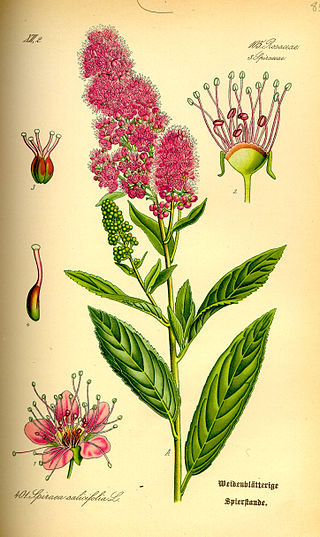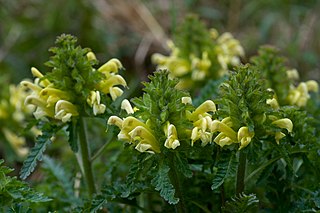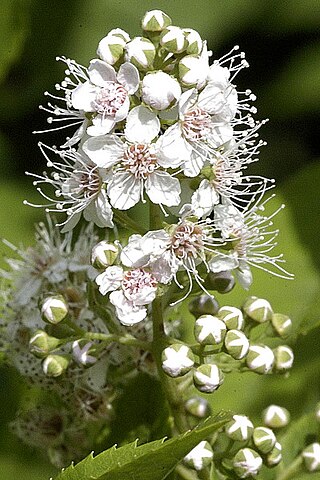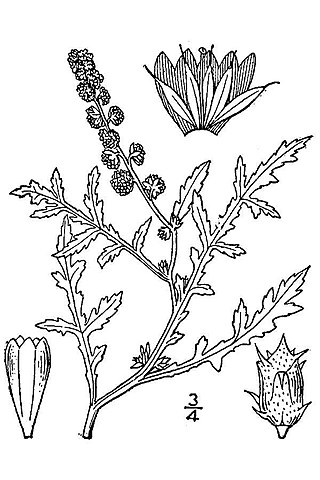
Ptelea trifoliata, commonly known as common hoptree, wafer ash, stinking ash, and skunk bush, is a species of flowering plant in the citrus family (Rutaceae). It is native to North America, where it is found in Canada, Mexico, and the United States. It is a deciduous shrub or tree, with alternate, trifoliate leaves.

Spiraea, sometimes spelled spirea in common names, and commonly known as meadowsweets or steeplebushes, is a genus of about 80 to 100 species of shrubs in the family Rosaceae. They are native to the temperate Northern Hemisphere, with the greatest diversity in eastern Asia.

Paulownia tomentosa, common names princess tree, empress tree, or foxglove-tree, is a deciduous hardwood tree in the family Paulowniaceae, native to central and western China. It is an extremely fast-growing tree with seeds that disperse readily, and is a persistent exotic invasive species in North America, where it has undergone naturalisation in large areas of the Eastern US. P. tomentosa has also been introduced to Western and Central Europe, and is establishing itself as a naturalised species there as well.

Spiraea douglasii is a species of flowering plant in the rose family native to western North America. Common names include hardhack,hardhack steeplebush, Douglas' spirea, douglasspirea, steeplebush, and rose spirea.

Pedicularis canadensis, commonly called Canadian lousewort or wood betony, is a flowering plant in the family Orobanchaceae. It is native to North America, where it is found in southeastern Canada, the eastern United States, and eastern Mexico. It has a wide-ranging natural habitat, being found in mesic to dry, forests, woodlands, and prairies.

Aconitum lycoctonum is a species of flowering plant in the genus Aconitum, of the family Ranunculaceae, native to much of Europe and northern Asia. It is found in lowlands to the subalpine zone, mainly in forests and shaded habitats. Along with A. napellus, A. lycoctonum is of the most common European species of the Aconitum genus. They are also grown ornamentally in gardens, thriving well in ordinary garden soil. As such, A. lycoctonum can be found in North America, especially in eastern Canada, often in old gardens or as garden escapees.

Cladrastis kentukea, the Kentucky yellowwood or American yellowwood, is a species of Cladrastis native to the Southeastern United States, with a restricted range from western North Carolina west to eastern Oklahoma, and from southern Missouri and Indiana south to central Alabama. The tree is sometimes also called Virgilia.

Iris lacustris, the dwarf lake iris, is a plant species in the genus Iris, subgenus Limniris and in the section Lophiris. It is a rhizomatous, beardless perennial plant, native to the Great Lakes region of eastern North America. It has lavender blue or violet-blue flowers, a very short stem and long fan-like green leaves. It is cultivated as an ornamental plant in temperate regions. It is closely related to Iris cristata.

Stellaria pubera, commonly called the star chickweed, is a spring-flowering plant in the carnation family Caryophyllaceae, native to the eastern United States.

Fraxinus profunda, the pumpkin ash, is a species of ash (Fraxinus) native to eastern North America, where it has a scattered distribution on the Atlantic coastal plain and interior lowland river valleys from the Lake Erie basin in Ontario and New York west to Illinois, southwest to Missouri and southeast to northern Florida. It grows in bottomland habitats, such as swamps, floodplains and riverbanks. It is threatened by the emerald ash borer, an invasive insect which has caused widespread destruction of ash trees in eastern North America.

Spiraea japonica, the Japanese meadowsweet or Japanese spiraea, is a plant in the family Rosaceae.

Prunus tomentosa is a species of Prunus native to northern and western China, Korea, Mongolia, and possibly northern India. Common names for Prunus tomentosa include Nanjing cherry, Korean cherry, Manchu cherry, downy cherry, Shanghai cherry, Ando cherry, mountain cherry, Chinese bush cherry, and Chinese dwarf cherry.

Spiraea alba, commonly known as meadowsweet, white meadowsweet, narrowleaf meadowsweet, pale bridewort, or pipestem, is native to the wet soils of the Allegheny Mountains and other portions of eastern North America, but is currently endangered in the state of Missouri. It is naturalized in other parts of the world.

Ambrosia tomentosa, the skeletonleaf bur ragweed, silverleaf povertyweed, or skeleton-leaf bursage, is a North American species of perennial plants in the family Asteraceae.

Ribes viscosissimum also known as sticky currant is a species of eudicot in the family Grossulariaceae. The species is native to North America. Pacific Northwest, Columbia Plateau, Great Plains, Great Basin, and southwest regions of western North America are native to this plant.

Enemion biternatum, commonly known as the false rue-anemone, is a spring ephemeral native to moist deciduous woodland in the eastern United States and extreme southern Ontario.

Xyris tennesseensis is a rare species of flowering plant in the family Xyridaceae known by the common name Tennessee yellow-eyed grass. It is native to a small section of the Southeastern United States, including parts of the states of Alabama, Georgia, and Tennessee. A federally listed endangered species, it is threatened by the loss and degradation of its habitat.

Gaylussacia frondosa is a species of flowering plant in the heath family known by the common names dangleberry and blue huckleberry. It is native to the eastern United States, where it occurs from New Hampshire to South Carolina.

Eucephalus vialis is a rare North American species of flowering plant in the family Asteraceae known by the common name wayside aster. It is native to southwestern Oregon and northwestern California in the United States.

Rubus flagellaris, the northern dewberry, also known as the common dewberry, is a North American species perennial subshrub species of dewberry, in the rose family. This dewberry is distributed across much of Canada, Mexico, and the United States. It grows in diverse habitats ranging from drier savannas to temperate deciduous forests.




















